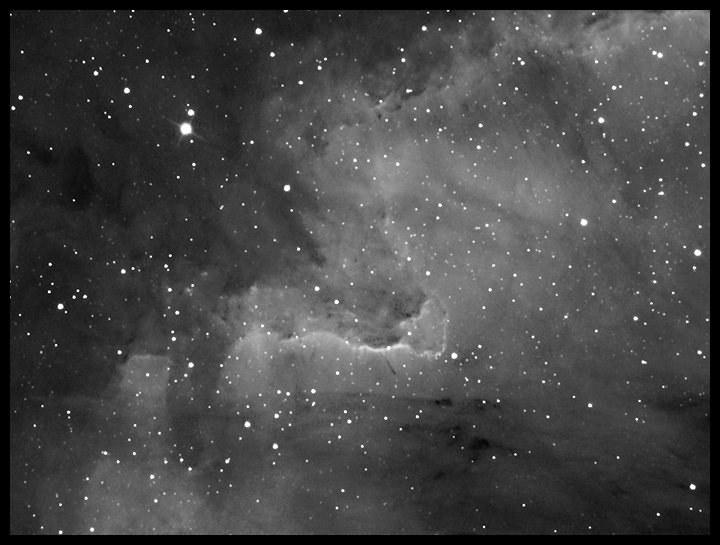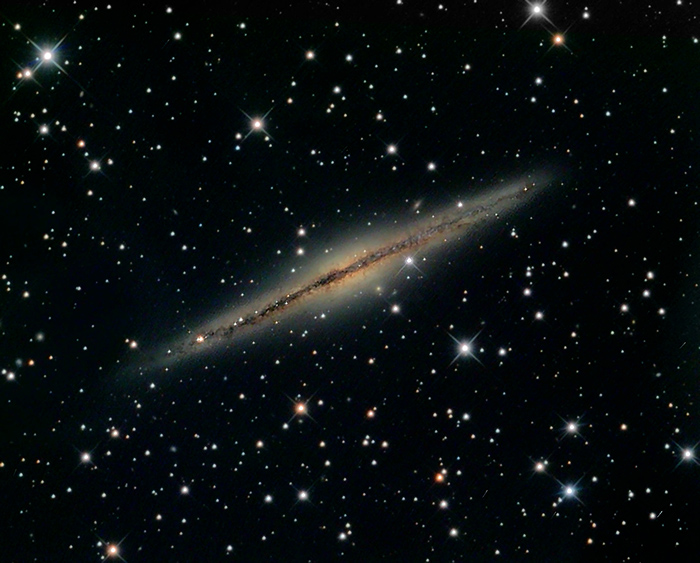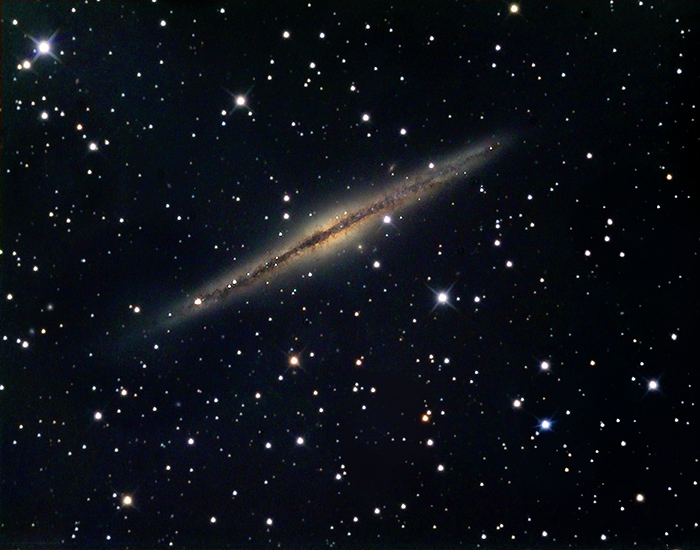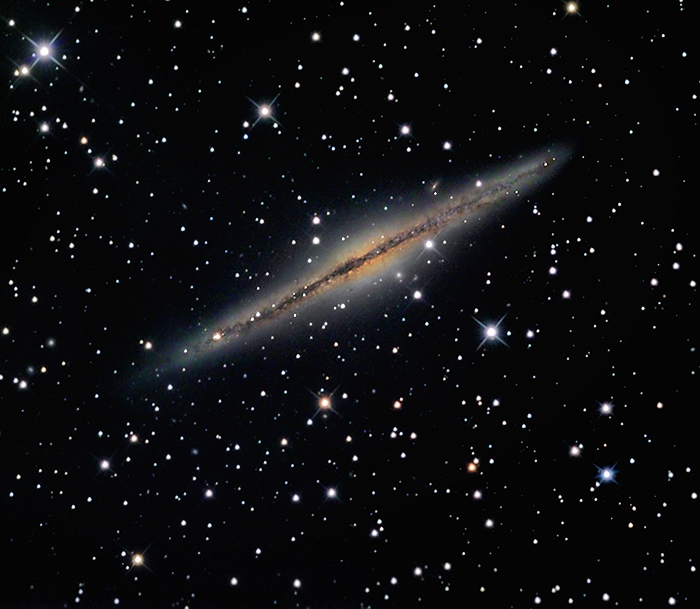11/18/2011. Revisiting "The Wall" in Cygnus... First, the camera mutineed and I lost an hour getting the CCD to respond to the computer. Evidently it was a USB connectivity thing since the computer kept dinging like a carillon as USB devices were detected, recognized, dismissed, rinsed and repeated. Whatever. After cycling the power a couple of times and replugging the main connections, all began working except Robofocus whose controller is again not being detected. Last time, I reverted the computer to get rid of some weeks worth of upates and cured this. I do not believe any updates have been applied since then, but I reverted to Halloween just in case. No luck. I recall seeing similar behavior back in July owing to a bad serial connection, so I'll look that over better by daylight.
It's a cold night. That's good because I can easily run the CCD at -40° for very quiet data. That's bad because I feel dreadful, and I don't want to stand around out there pushing buttons. I tapped the manual switches on RoboFocus until I had reasonably sharp stars then went inside to work on a section of The Wall adjoining the south side of my previous efforts:

NGC 7000 (detail)
7x1800s 7nm H-a filter
(The approximate frame center is 20h59m26s / +43o38')
That frame is tilted a few degrees relative to the cardinal directions which worked out well compositionally but was accidental and will make an eventual mosaic more challenging than intended. And it will make gathering more H-a data or color data tough. So put those markers back on the camera to make lining it up easier. Things cascade: I would've rotated it tonight but didn't want to have to refocus without the Robofocus controller behaving itself. It's also presented with north approximately to the right, but don't worry about that until I get a frame to the south of this one to complete a three frame mosaic of the mountains of Mexico within the North America Nebula.
After NGC 891 reached the zenith, I slewed to it and took 900s RGB subs. I'll do L frames for the rest of the night to supplement the previous take. Tomorrow night is not predicted to be good, so I can troubleshoot the outfit at leisure. Truth to tell, if tomorrow night had been predicted to be good, I'd've taken my croupy self to bed earlier tonight.
Also, some raw-to-me, scrap-to-them aluminum should arrive from a stock car building company down near Charlotte that I plan to use to turn some adapters for the cooling fan project (the boundary layer effort needs to be rethought in light of the tight spacing inside the R-C tube, but I can still have some fun right away adapting a new cooling fan to the rear cell). More -- probably too much -- about all that as I get into it.
In the meantime, here's the RGB data for NGC 891 combined with 5h30m of luminance from earlier in the fall:

NGC 891, an edge-on galaxy in Andromeda
22x900s L, 1x900s RGB
It's already much better color than in the LRGB frame constructed from R-C luminance data and A-P color frames and shown some days back. Matching luminance may come tomorow; at the very least, I need to reprocess the older luminance data using multiple darks to clean up the background without such aggressive treatment that the sky is dull and the stars messy. Stay tuned. Better to come, I emphatically hope.
Here's last night's result:

NGC 891
9x1800s L, 900s RGB
I don't know that that's much of an improvement. Because I've had the camera off the telescope since aquiring flats, I needed to make new ones, but I didn't. I think moonlight late and deteriorating transparency from midnight until dawn didn't help, either. The chip held -40° with ease. The extra darks help immensely. It's slightly defocussed (note especially the bright star at upper left, those broad, doubled diffraction spikes), but defocus is basically symmetrical and simple deconvolution can fix a lot of it. Note that the detail in the central lane (where I applied particularly aggressive decon) is at least as good as in the previous image. It will be nice to see what I get when I actually focus the telescope. There were 9 good images waiting on the computer this morning, so the thick overcast I am enjoying this morning must have arrived late. Tracking looked good all the way to the effective horizon (our roofline), and dew and frost were not a problem with two out of three fans turning.
About the focus issue: at a glance this morning, I saw that the USB-serial converter which allows RoboFocus and the computer to chat was only pretending to be connected. It's held together with two screws, so I'm not sure when or how they backed out. Surely I simply forgot to cinch them down during some previous troubleshooting session. I've put the connection back together and expect better results next time. [Yeppers: RoboFocus and the control computer are getting along famously.]
OK. Here we go, all the above data (minus one iffy shot in this morning's twilight) reasonably well calibrated with multiple darks and the best available flats:

NGC 891
8x1800s L, 22x900s L, 1x900s RGB
(9h15m total exposure)
That's looking pretty good.
NGC 891 is about 40 million light-years out and is said to be very similar to the Milky Way.
I'm wondering if I am seeing globular clusters just outside the halo, especially between 5 and 6 o'clock and farther out near 10 o'clock? The distance modulus to NGC 891 is about 30; clusters should be in the range of mv 17.5 to around 19.5 (an M13 equivalent) and below.
There are references in the literature, but I've not turned up a good map or anotated photo. Most candidates are said to lie within about 3 arc minutes of the nucleus, and on the assumption that many of the faint smudgy bits in the photo are in fact globulars, then that's about right. On the full-res image using all available L data, casual photometry in MaximDL (initialized using Guide 8 magnitudes) says the soft, slightly extended targets range from 17.8 to 21.7 with most in the 18.5 to 19.0 range. A few, however, are clearly more extended than globular clusters, so I may be seeing members of a far more distant cluster of galaxies beyond NGC 891 (or some combination of globulars and background galaxies). According to the ApJ Letters, there's also a large, intricate halo around NGC 891, but I see no sign of that in my images (yet). Here's a deep rendering of my best data of the central regions of NGC 891. Below each red tick mark is a (very) faint fuzzy thingawidget. I've marked only a fraction in the field of view which is about 6.5 arc minutes tall: